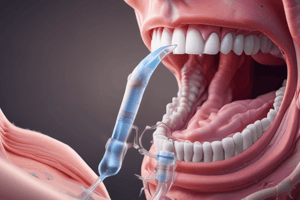Podcast
Questions and Answers
What is a common symptom of COPD?
What is a common symptom of COPD?
- Silent chest with sudden onset
- Barrel-chested appearance (correct)
- Hyperventilation without exertion
- Prolonged inhalation through pursed lips
Which of the following conditions is not encompassed by the general term COPD?
Which of the following conditions is not encompassed by the general term COPD?
- Chronic bronchitis
- Emphysema
- Pneumonia (correct)
- Bronchospasm
What age group has COPD been diagnosed in, according to the text?
What age group has COPD been diagnosed in, according to the text?
- As young as 40 years old (correct)
- Between 20 to 30 years old
- Exclusively in individuals under 40 years old
- Exclusively in individuals over 65 years old
In individuals with COPD, when are colds or the flu more likely to occur?
In individuals with COPD, when are colds or the flu more likely to occur?
Which disease is characterized by the alveoli losing their elasticity and becoming distended with trapped air?
Which disease is characterized by the alveoli losing their elasticity and becoming distended with trapped air?
What is the most effective way to counteract the effects of a reaction caused by COPD?
What is the most effective way to counteract the effects of a reaction caused by COPD?
What technique is recommended to open the patient's mouth when inserting the OPA?
What technique is recommended to open the patient's mouth when inserting the OPA?
What should you do if the patient gags when you attempt to insert the OPA?
What should you do if the patient gags when you attempt to insert the OPA?
Why should extra caution be taken when inserting an OPA in younger children and infants?
Why should extra caution be taken when inserting an OPA in younger children and infants?
How should you position an infant when inserting an OPA to avoid hyperextension of the neck?
How should you position an infant when inserting an OPA to avoid hyperextension of the neck?
What should you use to hold the tongue against the bottom of an infant's mouth when inserting an OPA?
What should you use to hold the tongue against the bottom of an infant's mouth when inserting an OPA?
What is the purpose of the inflatable cuffs on supraglottic airways?
What is the purpose of the inflatable cuffs on supraglottic airways?
Why should you rotate the OPA 90 degrees after gently sliding it along the inside of a child's cheek?
Why should you rotate the OPA 90 degrees after gently sliding it along the inside of a child's cheek?
Why are supraglottic airways not suitable for patients with active vomiting?
Why are supraglottic airways not suitable for patients with active vomiting?
In what cases are supraglottic airways contraindicated?
In what cases are supraglottic airways contraindicated?
What should be done before inserting the supraglottic airway (SGA)?
What should be done before inserting the supraglottic airway (SGA)?
How should one position themselves when inserting the supraglottic airway?
How should one position themselves when inserting the supraglottic airway?
Where should the SGA be directed during insertion?
Where should the SGA be directed during insertion?
What is the main reason for keeping the patient’s head tilted to an appropriate angle during ventilation?
What is the main reason for keeping the patient’s head tilted to an appropriate angle during ventilation?
What should be the frequency of ventilations for adults when ensuring a steady rhythm?
What should be the frequency of ventilations for adults when ensuring a steady rhythm?
What is another term for when air enters the patient’s stomach instead of the lungs?
What is another term for when air enters the patient’s stomach instead of the lungs?
In what scenario would mouth-to-stoma breathing be necessary?
In what scenario would mouth-to-stoma breathing be necessary?
Why is gastric distension considered a serious problem during assisted ventilation?
Why is gastric distension considered a serious problem during assisted ventilation?
What is the recommended technique when assessing the breathing of a patient with a stoma?
What is the recommended technique when assessing the breathing of a patient with a stoma?
What should you do if a patient's breathing is rapid due to emotions like excitement or anxiety?
What should you do if a patient's breathing is rapid due to emotions like excitement or anxiety?
What should you do if a patient has a pulse but is not breathing?
What should you do if a patient has a pulse but is not breathing?
When should you begin CPR for a patient who has no pulse and is not breathing?
When should you begin CPR for a patient who has no pulse and is not breathing?
What should you do if you suspect a patient's rapid breathing is caused by excitement?
What should you do if you suspect a patient's rapid breathing is caused by excitement?
How often should you check if a patient has begun to breathe spontaneously during assisted ventilation?
How often should you check if a patient has begun to breathe spontaneously during assisted ventilation?
If a patient's pulse is absent and they are not breathing, what action should be taken next as per the text?
If a patient's pulse is absent and they are not breathing, what action should be taken next as per the text?




